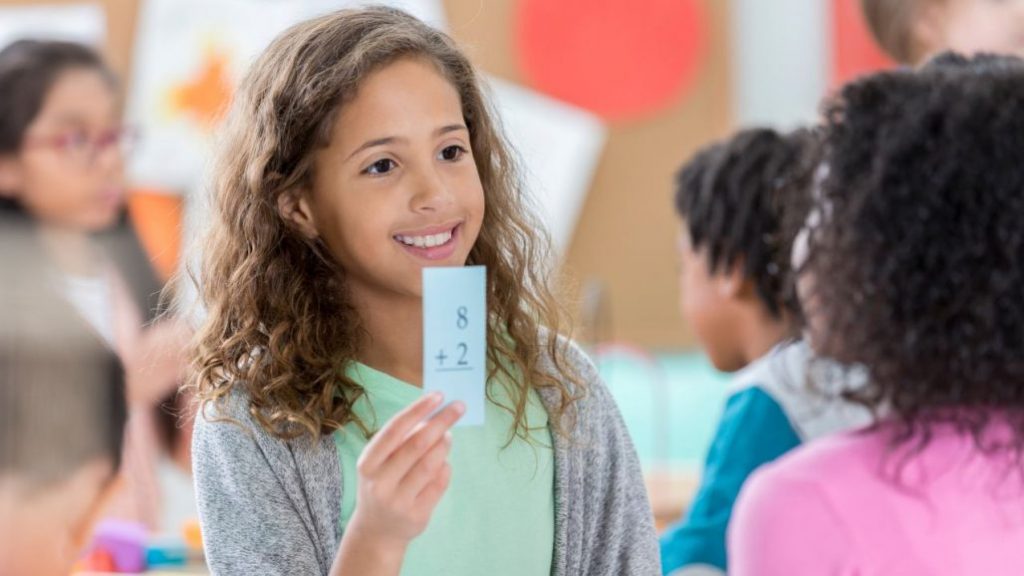Many parents recall their own school days when flashcards were a common study tool. Despite their long history, flashcards have retained their relevance and are still considered one of the most effective methods for mastering vocabulary, definitions, or formulas.
This article explains how one can use flashcards to not only aid in memorising vocabulary for the long term but also to facilitate optimal learning in various subjects.
What are flashcards?
Flashcards are generally small cards featuring vocabulary in a foreign language on one side and their English meanings on the other. For vocabulary learning, a card might display a full sentence or a keyword and its corresponding translation on the reverse side. This method is particularly effective for teaching English to children.
To memorise other content such as dates, facts, and formulas, one can write a question on the front of the card and the definition, translation, explanation, or answer on the back. Using images instead of words can make flashcards more appealing to children. Stickers and coloured highlights can also be helpful tools.
Students around the world have successfully used flashcards as self-made study aids for effective learning. The principle behind flashcards is simple, offering a systematic approach to organising knowledge, which differs significantly from tedious rote learning with lists, textbooks, or notes.
Who is suited for learning with flashcards?
Flashcards are ideal for children who are reluctant to devote extensive time to studying, are always on the go, participate in many extracurricular activities, and lack the motivation to study intensively.
Using flashcards for learning foreign languages, math formulas, or history allows a child to use their time effectively and acquire knowledge at any time, even during short breaks or while commuting to school.
Flashcard learning is effective for all ages, from primary and secondary education to higher studies and professional development. Proven effective in various subjects, flashcards are an incredibly versatile tool.
Using flashcards can also provide a fun opportunity for children of different ages and their parents to learn together. Families can create knowledge quizzes at home using flashcards, which are also great for keeping children entertained during travel while imparting new knowledge.

How does learning with flashcards work?
There is no set study plan for learning vocabulary with flashcards. One only needs a stack of flashcards and a pen, and perhaps some coloured pencils and stickers. Flashcards can be customised with vocabulary, drawings, mnemonics, or definitions, depending on how one best remembers information. Some people find visual aids like pictures more helpful, while others prefer numeric or textual cues.
Repetition is crucial for memorisation. It takes several rounds of review for all the information on each flashcard to be fully memorised. A child can learn alone by reading the terms aloud, with others, or in groups, for instance, by playing a knowledge quiz. The completed set of flashcards can be kept as a single stack, divided into several stacks, or organised in a flashcard box.
Vocabulary learning with flashcards: Simple and effective
The easiest method involves placing the double-sided flashcards in a stack. When reviewing, the learner sees one language on top and must recall the translation in the other language. To increase difficulty, they can also practice spelling the words.
If a response is correct, the flashcard is placed back at the bottom of the stack. If a learner struggles with a particular word, that card is moved to the middle of the stack for more frequent review. While learning independently with flashcards is possible, learning as a team is often more enjoyable and can enhance the learning experience.
Before each repetition, shuffling the cards creates new sequences, adding dynamism to the learning process and making it more engaging than monotonous rote learning. This way, learners become familiar with words independently and can more easily apply them in different contexts.
Learning with flashcards in a flashcard box
Another method involves organising pre-made flashcards into stacks or in a specialised flashcard box. For example, if using a box with three compartments, all cards start in the first compartment. As systematic learning and repetition progress, some terms will be easier for the learner to remember than others. It’s important to separate known words from those still challenging.
The first compartment should contain cards for daily practice, the second for every other day repetition, and the third for every third day review. If a learner translates a vocabulary word correctly on the first try, the card moves to a higher compartment, indicating it no longer requires daily repetition. If not yet mastered, it stays in or returns to the first compartment.
The objective is to master all flashcards and move them to the top compartment. Observing progress and systematically working towards this goal can be highly motivating.
Why is learning with flashcards so effective?
Flashcards are among the most effective methods for learning vocabulary, grammar, facts, formulas, or definitions. Importantly, learners are not just memorising the order of words as in poem recitation but are continually learning sentences and expressions usable in real-life conversations.
Another advantage of flashcards is that their creation is time-consuming and involves significant thought. Writing specific words and terms on flashcards helps embed the vocabulary during the creation of the study aid. Hence, it’s beneficial for learners to personally write and design their flashcards. When they begin learning with their self-created cards, they often find they already know some of the terms.
Flashcard learning is particularly suitable for visual and tactile learners who remember best through visual and physical stimuli. Moreover, flashcards enable quick, targeted term repetition and efficient time use, for example, during commutes or school breaks. Flashcards are an effective, enjoyable learning method that can be particularly fun in group settings like quizzes.
Vocabulary learning with flashcards: Tips for children
When creating and designing flashcards for vocabulary learning with children, the following tips can be useful. These apply to adults as well!
- Colourful design: Make the flashcards visually engaging. Children respond well to visual stimuli, so cards should be attractive and age-appropriate.
- Use of images: Incorporate images or drawings related to the vocabulary, enhancing the word’s meaning. Even colourful stickers can be used to aid visual learning.
- Short example sentences: Include brief sentences using new words in context. This helps learners understand and apply the word in real-life situations. Correct spelling is crucial.
- Repetition is key: Regular repetition solidifies learning and embeds information in long-term memory.
- Interactive and playful learning: Make learning a collaborative activity, turning vocabulary study into a fun quiz game.
- Optimal learning times: Identify the best times for learning. Some children learn better in the morning, others in the afternoon. Ensure the learner is rested and receptive.
- Small, regular learning units: Avoid overloading the cards with information and divide the material into manageable chunks. Learning under pressure can hinder success. Start early and maintain regular study habits.
- Patience: Learning pace varies for each individual. Be patient and encouraging, even if progress is slow at times.
- Daily application: Integrate learned words into daily life. For instance, identify colours while shopping or name animals during a walk.
- Collective learning: Engage in joint learning activities. Learning together can be enjoyable and strengthen bonds.
Remember, the joy of learning is paramount. Positive experiences in vocabulary learning can greatly enhance motivation. Flashcard learning should not be a short-term endeavour but a long-term part of daily life. With flashcards, material from all school subjects can be practised in an entertaining and quiz-like manner.
Looking for a reliable printing company?
Get an instant quote